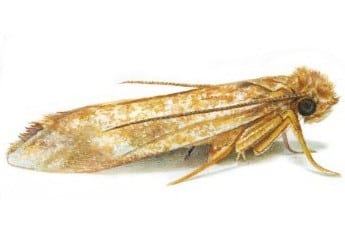Clothes Moths, Silverfish and Carpet Beetles, the fabric pests, are not uncommon even around the cleanest of homes. They are very destructive pests and specialist methods may be required to eliminate them from your home or business. The diets of these fabric pests are items commonly found around the home. Carpet beetles and moths seek out a protein called keratin which is a protein found in fibres of animal origin such as wool. Silverfish tend to eat substances of plant origin such as cotton, cellulose and starch. These pests usually operate quietly and unseen in the darkness of your cupboards or drawers and can cause irreparable damage to many common items so knowing their habits and knowing how to eliminate them are important.
Fabric Pests
Carpet Beetles
One of the less obvious “fabric” pests found in our homes is the carpet beetle. Small and sometimes not as visible as other pests, carpet beetles nonetheless can cause damage and need to be exterminated if an infestation is present

Carpet Beetles
Clothes Moths
Firstly, the Clothes Moth needs to be distinguished from the common flying house moth and one of the big differences is that unlike the house moth, clothes moths are not attracted to light and in fact tend to avoid lighted areas. Clothes moths are small (approx. 1 cm long) and buff or straw in colour and have 6 legs however damage is done not by the adult moth, but by the larvae. The adult tends to lay eggs on materials that provide an adequate food source for the emerging larvae which will be protected by a “case” made from the fibres of the material on which they are feeding
They prefer dirty fabric and are particularly attracted to carpeting and clothing that contain human sweat or have had other liquids spilt on them.

Clothes Moth
Silverfish
Another common household “fabric pest” is the silverfish. A nocturnal creature not often seen during the day, silverfish cause damage within homes by their diet requirements of sugar, starch and high protein products. Silverfish are wingless, primitive insects and can easily be identified by three long appendages protruding from the rear of their abdomens. They have a fishlike appearance with a tapered body approximately 2cm in length and a dull silvery colour
Silverfish need and constantly seek water and hence are frequently found trapped in sinks and bathtubs and quite often can be seen in bathrooms and basements and in fact in new buildings, where the masonry is still damp, they quite often can be found in large numbers. Silverfish activity can also be seen around bookcases, closet shelves, behind skirting boards and window and door frames. Silverfish will leave behind a small pelletised frass which resembles small mouse droppings and this may be scattered randomly under items or on surfaces

Silverfish
